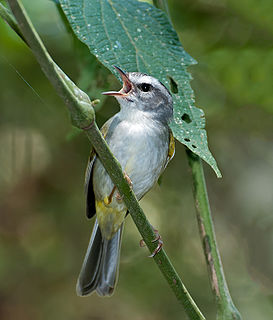
The New World warblers or wood-warblers are a group of small, often colorful, passerine birds that make up the family Parulidae and are restricted to the New World. They are not closely related to Old World warblers or Australian warblers. Most are arboreal, but some, like the ovenbird and the two waterthrushes, are primarily terrestrial. Most members of this family are insectivores.

The pale-legged warbler is a species of bird in the family Parulidae. It is native to Argentina, Bolivia, Colombia and Peru. Its habitats include subtropical or tropical moist montane, as well as subtropical or tropical heavily degraded former forest.

The golden-browed warbler is a species of bird in the family Parulidae, the New World warblers. It is found in El Salvador, Guatemala, Honduras, and Mexico. Its natural habitat is subtropical or tropical moist montane forests.

The two-banded warbler is a species of bird in the family Parulidae. It is found in Argentina, Bolivia, Brazil, Guyana, Peru, and Venezuela. Its natural habitats are subtropical or tropical moist montane forests and heavily degraded former forest.

The golden-bellied warbler or Cuzco Warbler is a South American species of bird in the family Parulidae. Its natural habitats are subtropical or tropical moist lowland forests, subtropical or tropical moist montane forests, and heavily degraded former forest.

The grey-throated warbler is a species of bird in the family Parulidae.

The white-lored warbler is a species of bird in the family Parulidae. It is endemic to the Santa Marta Mountains in Colombia.

The grey-headed warbler is a species of bird in the family Parulidae. It is endemic to Venezuela.

The white-bellied warbler is a bird in the family Parulidae. It is found in Bolivia, Brazil, and Paraguay. It resembles the closely related golden-crowned warbler, but its underparts are entirely whitish instead of yellow. Recently, the South American Classification committee of the AOU reclassified the white-bellied warbler as a subspecies of the golden-crowned warbler based on studies by Lovette et al. and Vilaca and Santos.

The Pirre warbler is a species of bird in the family Parulidae. It is found in the borderline area of Panama and Colombia. Its natural habitat is subtropical or tropical moist montane forests. It is threatened by habitat loss.

The white-rimmed warbler or white-browed warbler is a species of bird in the family Parulidae. It is found in Argentina, Brazil, Paraguay, and Uruguay. Its natural habitats are subtropical or tropical moist lowland forests, subtropical or tropical moist montane forests, subtropical or tropical moist shrubland, and heavily degraded former forest.

The citrine warbler is a species of bird in the family Parulidae. The term citrine refers to its yellowish colouration. It is found in Bolivia, Colombia, Ecuador, Peru, and Venezuela. Its natural habitat is subtropical or tropical moist montane forests.

The black-crested warbler is a species of bird in the family Parulidae. It is found in Colombia, Ecuador, Peru, and Venezuela. Its natural habitats are subtropical or tropical moist montane forests and heavily degraded former forest.

The three-banded warbler is a species of bird in the family Parulidae. It is found in Ecuador and Peru. Its natural habitats are subtropical or tropical moist montane forests and heavily degraded former forest.

The three-striped warbler is a species of bird in the family Parulidae. It was previously considered conspecific with the Tacarcuna warbler and the black-eared warbler. This bird is found in South America from Venezuela to Peru and Bolivia. Some authorities recognised birds from the southern part of the range as a separate species, the Yungas warbler.

The green-tailed warbler, also known as the green-tailed ground warbler, is a species of songbird endemic to the Caribbean island of Hispaniola and adjacent islets.

The white-winged warbler, also called the Hispaniolan highland-tanager, is a species of bird classified in the family Phaenicophilidae. It is the only member of the genus Xenoligea, and is endemic to the Caribbean island of Hispaniola.

Myiothlypis is a genus of New World warblers, best represented in Central and South America. This is one of only two warbler genera that are well represented in the latter continent. All of these species were formerly placed in the genus Basileuterus.

The black-eared warbler or Costa Rican warbler is a species of bird in the family Parulidae. It was previously considered conspecific with the three-striped warbler and the Tacarcuna warbler.
The Tacarcuna warbler is a species of bird in the family Parulidae. It was previously considered conspecific with the three-striped warbler, and the black-eared warbler.




















